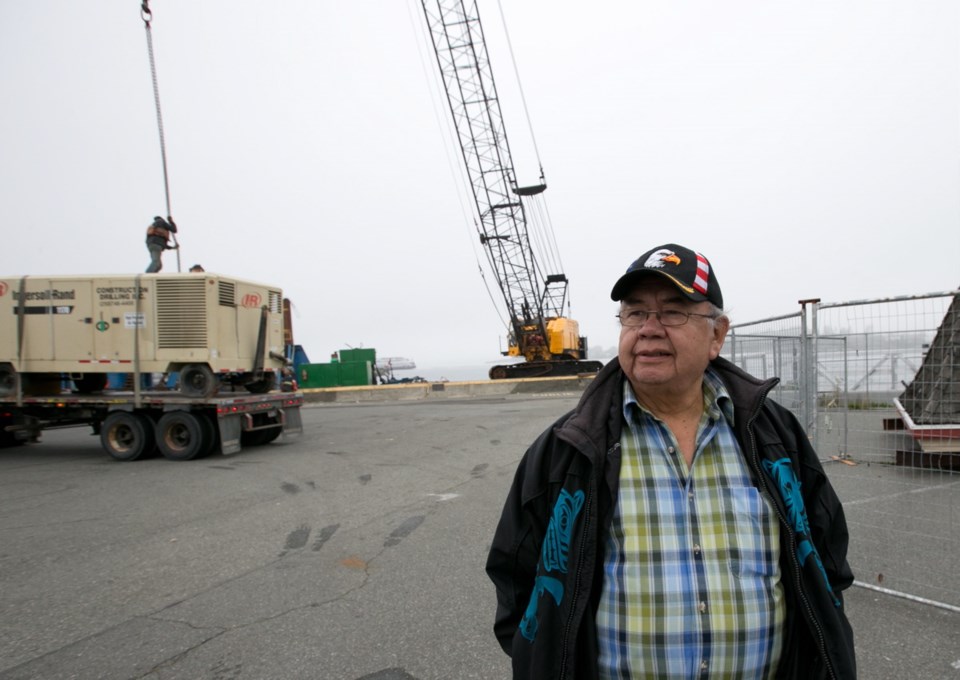Andy Thomas, hereditary leader of the Esquimalt First Nation for more than 35 years, cracks a proud smile as a 140-foot spud barge touches the pier at Ogden Point and its massive crane swings into gear to begin driving piles for a new docks.
“We’ve been kept out of the economy for too long, but now we are back,” says Thomas as he surveys the equipment and crews that make up Salish Sea Industrial Services Ltd., a pile-driving and dredging company launched last year by Ralmax Contracting and the Esquimalt and Songhees First Nations.
Salish Sea has earned $9 million in marine contracts in its first fiscal year. But the real value for Thomas is the employment and training for members of the local First Nations, who he says have been mired in poverty and see few opportunities to land highly skilled, well-paying jobs.
Salish Sea has 15 employees on two spud barges, including 10 aboriginals. That number is expected to grow as the company gains more contract work through competitive bid processes.
The company recently won a $4-million deal to replace the docks at the Royal Victoria Yacht Club, a job that is expected to start in January. The Songhees and Esquimalt own 51 per cent of the Salish Sea, with Ian Maxwell’s Ralmax owning the remaining shares.
For the Songhees and Esquimalt nations, the two barges and cranes that make up the Salish Sea Industrial fleet are having a very visual impact on their own people and the public. He said the company is showing that a viable business is a path out of poverty and away from stereotypes.
“For us, Salish Sea Industrial is a big opportunity to become visible, because we’ve been invisible for a long time,” said Thomas. He looked around Ogden Point, noting the cruise-ship terminal once held a fish-processing plant and there were sawmills dotted around the city that provided his generation with steady, well-paid work.
But that has dried up, leaving First Nations with fewer employment opportunities, he said. “When I was a boy, we worked in fish or wood but it was all gone in the 1980s,” said Thomas. “We had 95 per cent employment back then. When it all fell out we had 95 per cent unemployment.
“Having the opportunity to own a business gives our people a chance to be part of the workforce and make a decent wage,” added Thomas. “A worker can buy a new car or a computer for his child to go to school. This is a good beginning.”
Jerome Thomas, 32, has been working on the barge since its was launched. He had a job at Maxwell’s Ellice Recycle, but shifted to Salish Industrial to apply his mechanical skills.
“It feels really good to have this job. It gives you a real sense of pride,” said Jerome. He makes $29 an hour and that gives him stability with a two young children.
“In my other jobs [as a mason and mechanic] you work all over and you make small amounts of money,” he said. “Now I say I have a career, not a job.”
Christina Clarke, director of operations for Songhees Nation, said Salish Sea Industrial gives local band members opportunities to learn trades, earn better wages and gain a better standard of living. She is encouraging all youth, including females, to enter trades training and take advantage of new business opportunities in First Nations and other private businesses.
She points to the maritime training centre recently built on Esquimalt lands, where young people are being trained to meet the demands of the resurging shipbuilding industry.
The big success with Salish Sea is the training component. It was designed with Esquimalt and Songhees officials with the idea they must work together to develop the skills of aboriginal youth in order to be competitive and contribute to the workforce and overall economy.
Chief Thomas noted Salish Sea Industrial’s significance of returning to local harbour waters, where ancestors created “proud livelihoods.”
He said it is one of the few opportunities to create wealth for the Esquimalt reserve, stranded within the city for decades. They are now expanding with a barge dock at Plumper Bay to assist the federal government, CFB Esquimalt and other industries that require barge/land access and spud barge services.
Salish Industrial’s largest contract was worth $5 million and involved work at the Esquimalt Graving Dock. The company also did dredging for the B.C. Hydro site in the Upper Harbour, docks for Harbour Air Seaplanes and sampling of the ocean floor for private engineering firms.



